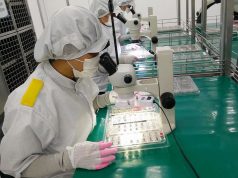Sunico is new Steinway artist

THE melody of Ernani Cuenco’s “Bato sa Buhangin” filled the room, the polished notes coming from a Steinway & Sons Spirio player piano. When the recording ended, pianist and composer Raul M. Sunico stepped onstage and performed the same piece romantically with precision.
That day, the Steinway Boutique Manila named Mr. Sunico, a multi-awarded international concert pianist and composer, as its new Steinway Artist, the third Filipino Steinway Artist following Cecile Licad and Victor Asuncion.
According to Celine Goh, general manager of Steinway Gallery Singapore, a musician has to have virtuosity and have made a significant contribution to the local music industry to qualify as a Steinway artist.
“Being a Steinway artist, you have access to the worldwide dealership. If there’s no Steinway available at the venue [of your concert], you could approach one of our dealers so you can borrow a Steinway,” Ms. Goh told BusinessWorld in an interview prior to the evening ceremony at Steinway Boutique Manila in Shangri-La Plaza on March 21.
Founded in 1853 by German immigrant Henry Engelhard Steinway, the piano continues to be handcrafted with high standards for sound and investment value. Its models include the classic Steinway, the Boston, and the Essex. Classical pianist Lang Lang, jazz artist Diane Krall, and rock ‘n’ roll singer and pianist Billy Joel are included on the roster of Steinway artists.
“We’re using this platform to feature outstanding pianists in this region and to recognize them for their work and their effort,” Ms. Goh added.
Mr. Sunico is the current chair of the doctoral program in music of St. Paul University in Manila and is a faculty member at the UST Conservatory of Music. He was president of the Cultural Center of the Philippines (CCP) from 2010 to 2017. His awards include A 1986 TOYM (The Outstanding Young Men of the Philippines) Award for Music, the 2015 Presidential Order of Merit, and the FCCP Award for Excellence in Music from the Friends for Cultural Concerns of the Philippines in 2017. He has had international solo recitals in various countries and recorded around 50 albums.
“The piano is silent without the artist. So, you need artists to bring out the best of the instrument. We have a very exclusive group of renowned artist who come together in Steinway programs who represent the brand,” Ms. Goh said
THE MUSIC AND THE VIRTUOSO
In November 2018, Mr. Sunico was at the Steinway Hall in New York to record five Filipino pieces including Ernani Cuenco’s “Bato sa Buhangin” and Mike Velarde’s “Buhat” — his contributions to the growing Steinway Spirio library of Filipino music.
The Spirio is a high resolution player piano — a self-playing piano with a mechanism that operates the piano action via pre-programmed music. While in the old days the music of the player piano, also known as a pianola, was recorded on perforated paper, modern iterations such as the Spirio use more high-tech means.
“My reason for recording Filipino songs is to put the Filipino repertoire in the library of international pieces,” Mr. Sunico said at the ceremony.
The songs were recorded for Spirio pianos to accurately reperform. The high resolution technology of the Spirio is able to record the smallest details of sound. The piano is built with technology which can change the songs dynamics such as volume, speed, and pedalling while recording. After recording, the music can be played back through activating the Bluetooth of the piano and Spirio app through a gadget.
“Different pianos have different qualities. Without comparing it to other pianos, it has, of course, an excellent sound,” Mr. Sunico told BusinessWorld about playing a Steinway. “It is always inspiring to play and to listen to one.”
As a new Steinway Artist, Mr. Sunico will be performing in a concert series titled Pioneering Pianists of South East Asia at the Victoria Concert Hall in Singapore in June.
Steinway & Sons is located at Level 1 EDSA Shangri-la Plaza East Wing, Mandaluyong City. For more information, visit www.steinway-boutique.com.ph. — Michelle Anne P. Soliman



